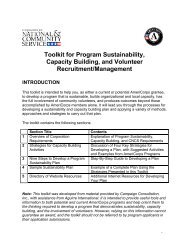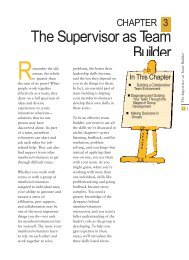MAKE IT LAST FOREVER: THE ... - National Service Resource Center
MAKE IT LAST FOREVER: THE ... - National Service Resource Center
MAKE IT LAST FOREVER: THE ... - National Service Resource Center
You also want an ePaper? Increase the reach of your titles
YUMPU automatically turns print PDFs into web optimized ePapers that Google loves.
(8) Schools which have received Learn and Serve grants have not substantially influenced district goals, policies, or support for<br />
service-learning; they generally do not have the time or inclination to do this, even though their own practice is improving.<br />
(9) State-level support for service-learning, including the development of policy, standards integration, systemic professional<br />
development, and resources, is unlikely to occur without employing at least one full-time coordinator in the state departments of<br />
education. This person must be well-trained and have the power to utilize department resources to support the institutionalization<br />
strategies.<br />
(10) This research did not elucidate the one or two most important factors in the service-learning institutionalization process. While<br />
many national advocates place emphasis on policy and funding, this study did not fully support that viewpoint. It did, however,<br />
illustrate the dynamic relationship among the various approaches and the importance of using multiple approaches simultaneously in<br />
order to achieve positive results.<br />
(11) A toolkit for assessing and designing institutionalization processes at the state, district, and school levels is needed to help<br />
interested parties to apply the conceptual framework of this research. States may also require technical assistance to facilitate an<br />
effective strategic planning initiative.<br />
(12) The work and processes of model schools and districts deserves to be highlighted and disseminated formally throughout the<br />
country. This study, for example, could form the basis of a new database of institutionalization efforts nationwide that is searchable by<br />
strategy, type of institution, or geographic area.<br />
(13) The success of many strategies (e.g., conferences, professional development, evidence of impact, youth leadership) is dependent<br />
upon consistent long-term support. These approaches cannot influence systemic change if done only once or twice, and this is why<br />
some form of permanent state service-learning infrastructure is important.<br />
(14) The research did not provide conclusive evidence that top-down institutionalization strategies, those stemming from the state or<br />
district level, are any more or less significant than bottom-up school-based approaches of principals, teachers and students. Clearly,<br />
strategies from both directions are important, and they can complement one another very well.<br />
(15) The process of institutionalizing service-learning can be expedited through formal planning efforts. Many states have districts<br />
which are unaware of service-learning, and rather than waiting for the approach to organically find its way to those places, planning<br />
can inform methods of promotion and capacity-building. State or CNS funding for such planning is a critical need.<br />
(16) The size of schools and districts is an important factor in institutional change, as smaller institutions seem to have clearer lines of<br />
communication, more faculty participation in decision-making, and lower teacher-student ratios, all of which favors the kind of<br />
autonomy and creativity that facilitates service-learning institutionalization.<br />
RECOMMENDATIONS<br />
115










